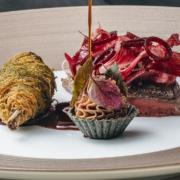Tomato and Olive Linguine is the perfect pasta for speedy suppers

This is a sumptuous velvety dish which is quick and easy to make, but none the less extravagant for it.
This recipe developed out of the exemplary pasta dish: spaghetti aglio, olio e pepperoncino, that’s spaghetti with olive oil, garlic and chilli to us. I first tasted this rather prosaic sounded dish in a restaurant in Sorrento and as with a simple dish of penne with zucchini I understood that the Italians as with the Japanese are the world masters of zen cooking; good, fresh, simple, quality ingredients perfectly married with similar ingredients.
Over the years, the spaghetti dish developed into this recipe for practical reasons, such as adding liquid to stop the garlic from burning and adding tomatoes and olives to up the five-a-day quotient.
I have switch the spaghetti to linguine as its thicker surface area captures and retains that unctuous sauce better. For after all this is comfort food Italian style.
INGREDIENTS
extra virgin olive oil
small sweet tomatoes
2-3 cloves garlic
1-2 fresh chilli peppers
black pitted olives
Cornish double cream
freshly grated parmesan cheese
Fresh herbs (rosemary, thyme, oregano, basil)
Cornish sea salt
freshly ground black pepper
vegetable stock cube/pot
linguine pasta (100g per person)
METHOD OF COOKING
This is a very quick, simple and very satisfying meal to cook. It does need to be properly prepped though as its cooking time is basically the length of time needed to cook the linguine.
Place a large frying/sauté pan on the stove and pour a generous amount of extra virgin olive oil on the bottom, enough to at least coat it. Slice some small, sweet tomatoes in half and place seed side down in the olive oil.
Peel and finely chop two or three cloves of garlic and one or two fresh chillies. Have some black olives prepared to go in the pan. I usually add around two dozen for good measure. This is also a good time to chop some fresh rosemary and pull off some thyme tips, or chop some fresh oregano, if you have some. If you don’t have fresh herbs and in Cornwall there’s no reason why you wouldn’t, use some dried Italian or Mediterranean herbs instead.
Put a full kettle on the boil and get a deep pan and add a splash of olive oil (to stop the pasta from sticking) plenty of Cornish sea salt, I usually add a couple of pinches, and a vegetable stock cube/pot. This seems extravagant but I want some of that cooking broth later for the pasta sauce. When the kettle has boiled pour into the pasta pan and bring back up to a rolling boil on the stove top.
Put the tomatoes on at a low to medium heat and put your linguine in the large pan of boiling water to cook. I use tongs periodically to pick the pasta up and separate it to make sure it doesn’t stick together and to ensure that it cooks evenly. I’ve used linguine because the sauce coats it luxuriously but spaghetti, or pappardelle, would both work well.
When the tomatoes have started to cook, toss in the olives, garlic, chillies and herbs. Try not to disturb the tomatoes too much, shake the pan to release their sweet juices rather than tossing them around. After about five minutes add into the sauce pan a couple of tablespoons of the liquor from the pasta. Let those juices infuse for a moment before adding some fresh double cream, a couple of tablespoons should be sufficient. You want a sauce that coats the pasta rather than swims around the plate. Always remember the pasta is the star, the sauce is a mere accompaniment and dressing. Next add some fresh Cornish sea salt and fresh cracked black pepper. At this point I also add a decent grating of good quality Parmesan cheese, again a couple of tablespoons worth, just to thicken the sauce and give it that extra umami flavour. Remember to save some Parmesan for the table of course. The last thing I add to the sauce is some freshly chopped basil.
It’s important to emphasise timing with this meal, it is everything, as the sauce can wait but the pasta can’t. Get a colander ready in the sink, pour the cooked pasta out but save some of the cooking liquor with it. Pour the pasta back in the pan, or if you have enough room preferably into the pan with the sauce in it. Toss the pasta in the sauce with tongs, trying to disturb the tomatoes as little as possible and serve immediately.
Pasta dishes should be made with simple, quality ingredients, that’s what makes them work so well and give you that serene glow of satisfaction afterwards.
Ewen MacDonald is a regular contributor to Cornwall Life magazine.



























